BA6052 Project Management Coursework: Cost, Schedule, and Tracking
VerifiedAdded on 2023/06/10
|12
|2913
|339
Project
AI Summary
This project management assignment analyzes various aspects of project execution, including causes of project clashes like budget issues, ego conflicts, and communication breakdowns. It details methods to solve these issues, such as proactive management and clear goal setting. The assignment then uses a Microsoft Project Management illustration to outline tasks, resources, and scheduling, including calendar modifications for holidays. It explores cost allocation within a project, the importance of project tracking through baseline and schedule data, and explains cost variance. The assignment emphasizes the role of schedule data in controlling projects and the impact of public holidays on project timelines. Overall, the assignment provides a comprehensive overview of project management principles and practices, focusing on cost, schedule, and project tracking.

Project Management 1
Project Management
Student’s Name
Course Code and Name
Instructor’s Name
Institution’s Name
City State
Project Management
Student’s Name
Course Code and Name
Instructor’s Name
Institution’s Name
City State
Paraphrase This Document
Need a fresh take? Get an instant paraphrase of this document with our AI Paraphraser
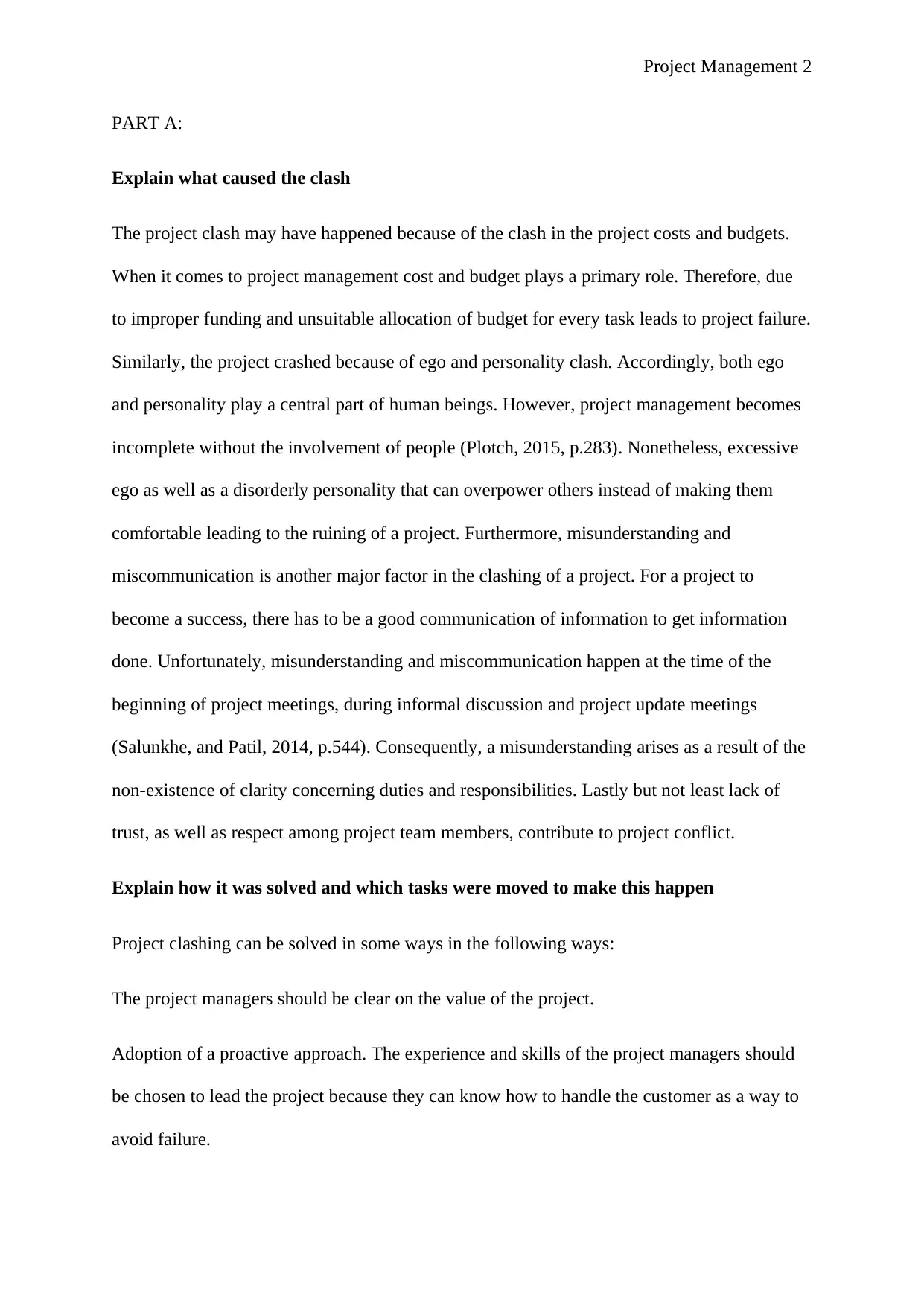
Project Management 2
PART A:
Explain what caused the clash
The project clash may have happened because of the clash in the project costs and budgets.
When it comes to project management cost and budget plays a primary role. Therefore, due
to improper funding and unsuitable allocation of budget for every task leads to project failure.
Similarly, the project crashed because of ego and personality clash. Accordingly, both ego
and personality play a central part of human beings. However, project management becomes
incomplete without the involvement of people (Plotch, 2015, p.283). Nonetheless, excessive
ego as well as a disorderly personality that can overpower others instead of making them
comfortable leading to the ruining of a project. Furthermore, misunderstanding and
miscommunication is another major factor in the clashing of a project. For a project to
become a success, there has to be a good communication of information to get information
done. Unfortunately, misunderstanding and miscommunication happen at the time of the
beginning of project meetings, during informal discussion and project update meetings
(Salunkhe, and Patil, 2014, p.544). Consequently, a misunderstanding arises as a result of the
non-existence of clarity concerning duties and responsibilities. Lastly but not least lack of
trust, as well as respect among project team members, contribute to project conflict.
Explain how it was solved and which tasks were moved to make this happen
Project clashing can be solved in some ways in the following ways:
The project managers should be clear on the value of the project.
Adoption of a proactive approach. The experience and skills of the project managers should
be chosen to lead the project because they can know how to handle the customer as a way to
avoid failure.
PART A:
Explain what caused the clash
The project clash may have happened because of the clash in the project costs and budgets.
When it comes to project management cost and budget plays a primary role. Therefore, due
to improper funding and unsuitable allocation of budget for every task leads to project failure.
Similarly, the project crashed because of ego and personality clash. Accordingly, both ego
and personality play a central part of human beings. However, project management becomes
incomplete without the involvement of people (Plotch, 2015, p.283). Nonetheless, excessive
ego as well as a disorderly personality that can overpower others instead of making them
comfortable leading to the ruining of a project. Furthermore, misunderstanding and
miscommunication is another major factor in the clashing of a project. For a project to
become a success, there has to be a good communication of information to get information
done. Unfortunately, misunderstanding and miscommunication happen at the time of the
beginning of project meetings, during informal discussion and project update meetings
(Salunkhe, and Patil, 2014, p.544). Consequently, a misunderstanding arises as a result of the
non-existence of clarity concerning duties and responsibilities. Lastly but not least lack of
trust, as well as respect among project team members, contribute to project conflict.
Explain how it was solved and which tasks were moved to make this happen
Project clashing can be solved in some ways in the following ways:
The project managers should be clear on the value of the project.
Adoption of a proactive approach. The experience and skills of the project managers should
be chosen to lead the project because they can know how to handle the customer as a way to
avoid failure.
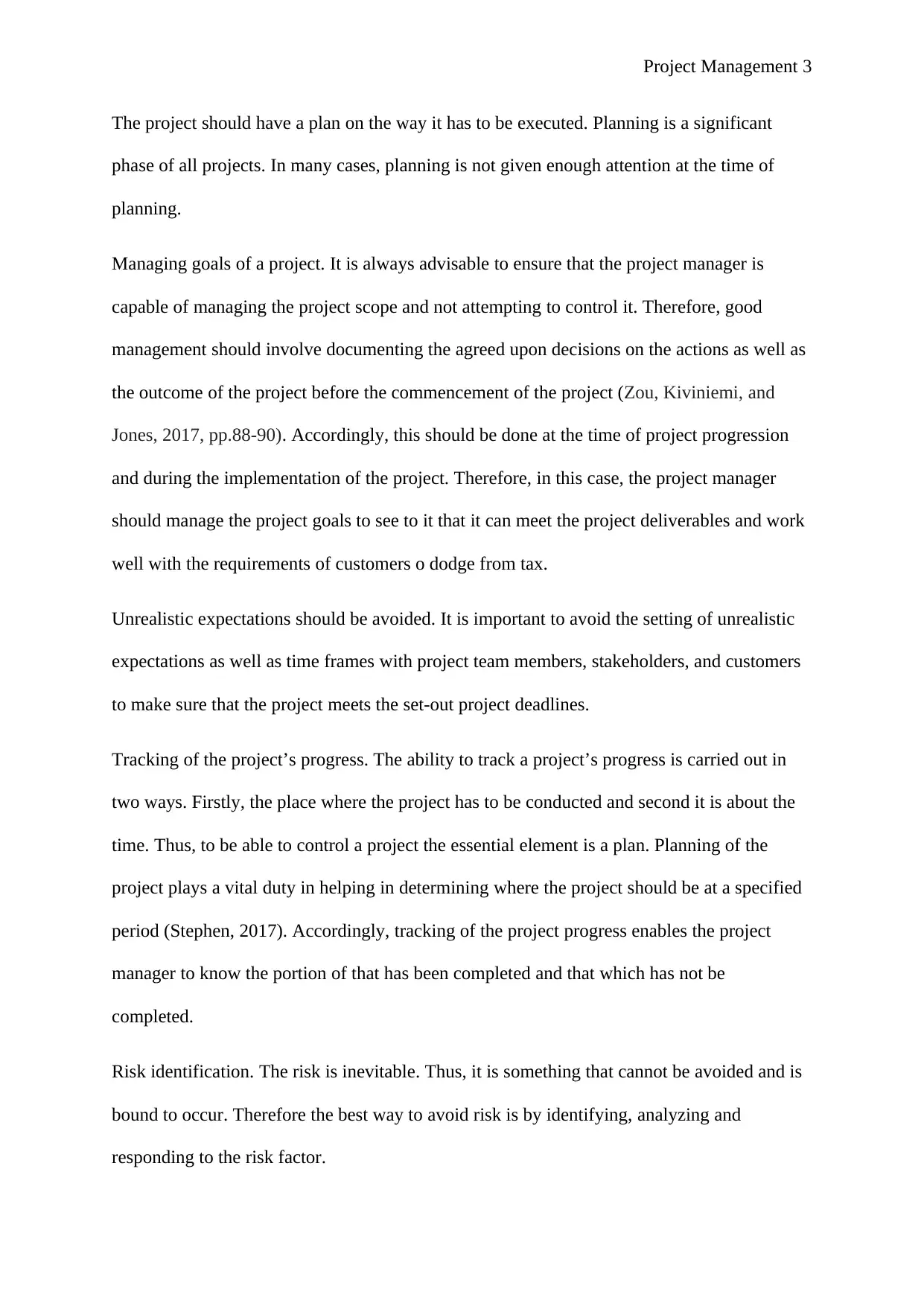
Project Management 3
The project should have a plan on the way it has to be executed. Planning is a significant
phase of all projects. In many cases, planning is not given enough attention at the time of
planning.
Managing goals of a project. It is always advisable to ensure that the project manager is
capable of managing the project scope and not attempting to control it. Therefore, good
management should involve documenting the agreed upon decisions on the actions as well as
the outcome of the project before the commencement of the project (Zou, Kiviniemi, and
Jones, 2017, pp.88-90). Accordingly, this should be done at the time of project progression
and during the implementation of the project. Therefore, in this case, the project manager
should manage the project goals to see to it that it can meet the project deliverables and work
well with the requirements of customers o dodge from tax.
Unrealistic expectations should be avoided. It is important to avoid the setting of unrealistic
expectations as well as time frames with project team members, stakeholders, and customers
to make sure that the project meets the set-out project deadlines.
Tracking of the project’s progress. The ability to track a project’s progress is carried out in
two ways. Firstly, the place where the project has to be conducted and second it is about the
time. Thus, to be able to control a project the essential element is a plan. Planning of the
project plays a vital duty in helping in determining where the project should be at a specified
period (Stephen, 2017). Accordingly, tracking of the project progress enables the project
manager to know the portion of that has been completed and that which has not be
completed.
Risk identification. The risk is inevitable. Thus, it is something that cannot be avoided and is
bound to occur. Therefore the best way to avoid risk is by identifying, analyzing and
responding to the risk factor.
The project should have a plan on the way it has to be executed. Planning is a significant
phase of all projects. In many cases, planning is not given enough attention at the time of
planning.
Managing goals of a project. It is always advisable to ensure that the project manager is
capable of managing the project scope and not attempting to control it. Therefore, good
management should involve documenting the agreed upon decisions on the actions as well as
the outcome of the project before the commencement of the project (Zou, Kiviniemi, and
Jones, 2017, pp.88-90). Accordingly, this should be done at the time of project progression
and during the implementation of the project. Therefore, in this case, the project manager
should manage the project goals to see to it that it can meet the project deliverables and work
well with the requirements of customers o dodge from tax.
Unrealistic expectations should be avoided. It is important to avoid the setting of unrealistic
expectations as well as time frames with project team members, stakeholders, and customers
to make sure that the project meets the set-out project deadlines.
Tracking of the project’s progress. The ability to track a project’s progress is carried out in
two ways. Firstly, the place where the project has to be conducted and second it is about the
time. Thus, to be able to control a project the essential element is a plan. Planning of the
project plays a vital duty in helping in determining where the project should be at a specified
period (Stephen, 2017). Accordingly, tracking of the project progress enables the project
manager to know the portion of that has been completed and that which has not be
completed.
Risk identification. The risk is inevitable. Thus, it is something that cannot be avoided and is
bound to occur. Therefore the best way to avoid risk is by identifying, analyzing and
responding to the risk factor.
⊘ This is a preview!⊘
Do you want full access?
Subscribe today to unlock all pages.

Trusted by 1+ million students worldwide
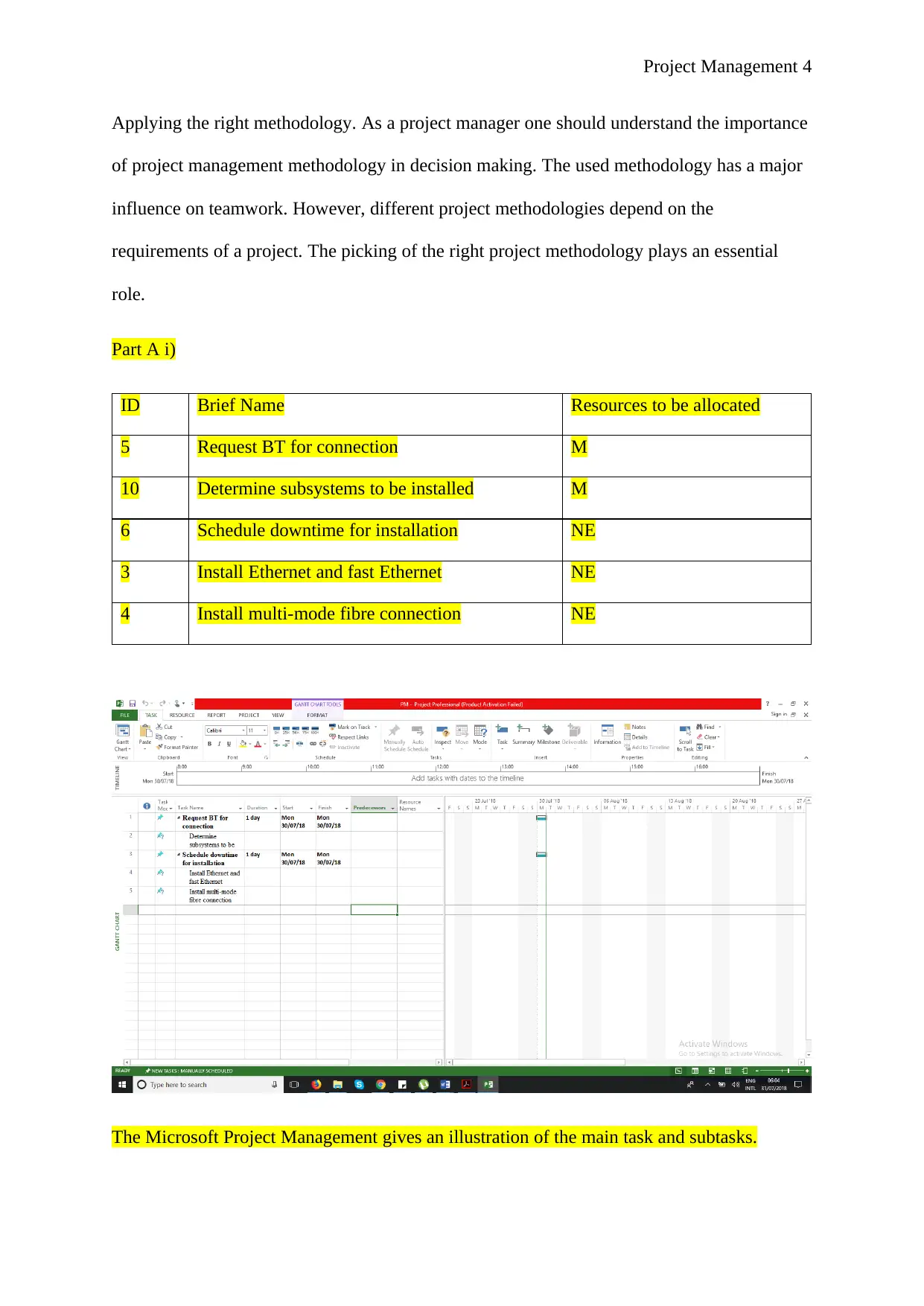
Project Management 4
Applying the right methodology. As a project manager one should understand the importance
of project management methodology in decision making. The used methodology has a major
influence on teamwork. However, different project methodologies depend on the
requirements of a project. The picking of the right project methodology plays an essential
role.
Part A i)
ID Brief Name Resources to be allocated
5 Request BT for connection M
10 Determine subsystems to be installed M
6 Schedule downtime for installation NE
3 Install Ethernet and fast Ethernet NE
4 Install multi-mode fibre connection NE
The Microsoft Project Management gives an illustration of the main task and subtasks.
Applying the right methodology. As a project manager one should understand the importance
of project management methodology in decision making. The used methodology has a major
influence on teamwork. However, different project methodologies depend on the
requirements of a project. The picking of the right project methodology plays an essential
role.
Part A i)
ID Brief Name Resources to be allocated
5 Request BT for connection M
10 Determine subsystems to be installed M
6 Schedule downtime for installation NE
3 Install Ethernet and fast Ethernet NE
4 Install multi-mode fibre connection NE
The Microsoft Project Management gives an illustration of the main task and subtasks.
Paraphrase This Document
Need a fresh take? Get an instant paraphrase of this document with our AI Paraphraser
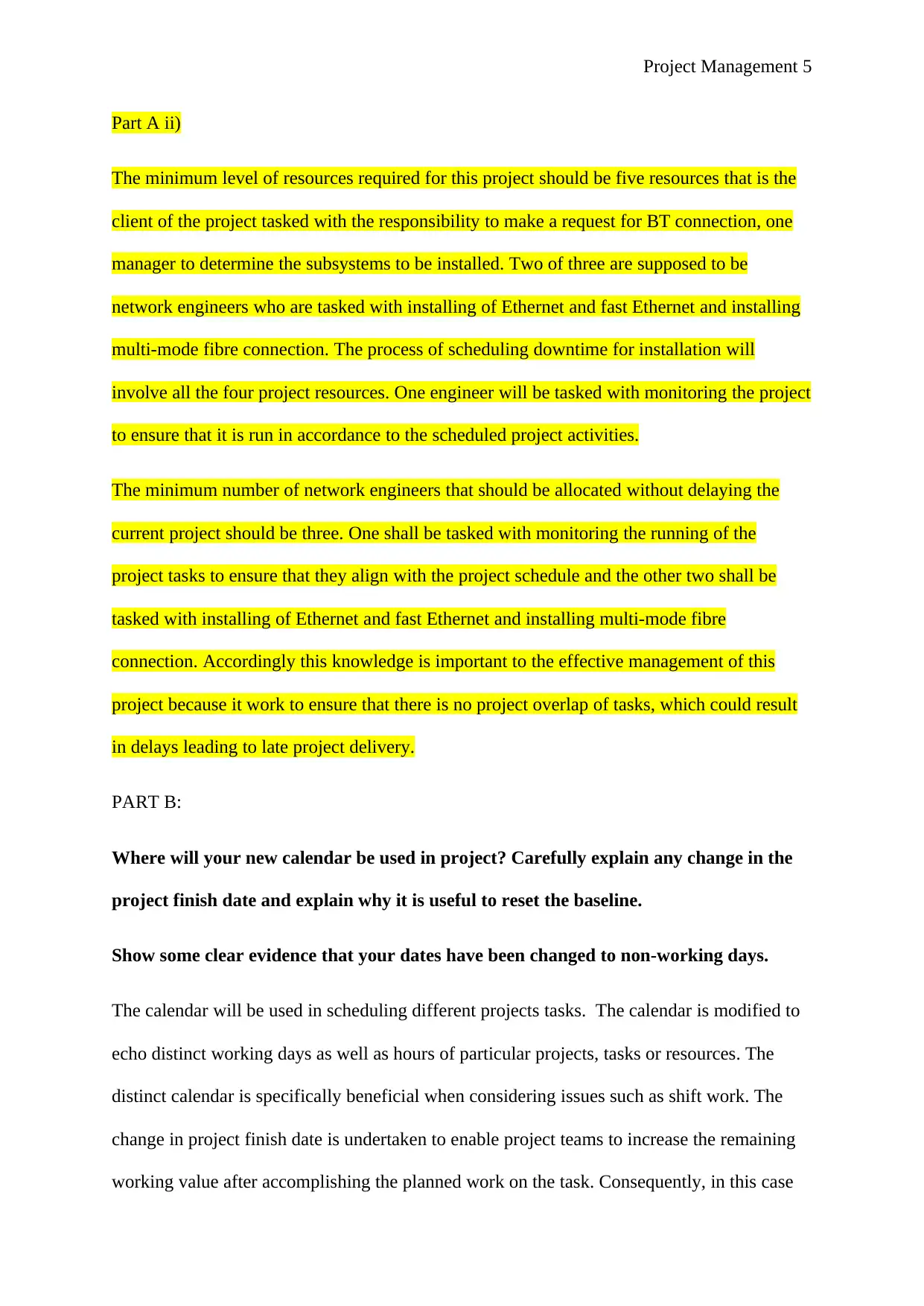
Project Management 5
Part A ii)
The minimum level of resources required for this project should be five resources that is the
client of the project tasked with the responsibility to make a request for BT connection, one
manager to determine the subsystems to be installed. Two of three are supposed to be
network engineers who are tasked with installing of Ethernet and fast Ethernet and installing
multi-mode fibre connection. The process of scheduling downtime for installation will
involve all the four project resources. One engineer will be tasked with monitoring the project
to ensure that it is run in accordance to the scheduled project activities.
The minimum number of network engineers that should be allocated without delaying the
current project should be three. One shall be tasked with monitoring the running of the
project tasks to ensure that they align with the project schedule and the other two shall be
tasked with installing of Ethernet and fast Ethernet and installing multi-mode fibre
connection. Accordingly this knowledge is important to the effective management of this
project because it work to ensure that there is no project overlap of tasks, which could result
in delays leading to late project delivery.
PART B:
Where will your new calendar be used in project? Carefully explain any change in the
project finish date and explain why it is useful to reset the baseline.
Show some clear evidence that your dates have been changed to non-working days.
The calendar will be used in scheduling different projects tasks. The calendar is modified to
echo distinct working days as well as hours of particular projects, tasks or resources. The
distinct calendar is specifically beneficial when considering issues such as shift work. The
change in project finish date is undertaken to enable project teams to increase the remaining
working value after accomplishing the planned work on the task. Consequently, in this case
Part A ii)
The minimum level of resources required for this project should be five resources that is the
client of the project tasked with the responsibility to make a request for BT connection, one
manager to determine the subsystems to be installed. Two of three are supposed to be
network engineers who are tasked with installing of Ethernet and fast Ethernet and installing
multi-mode fibre connection. The process of scheduling downtime for installation will
involve all the four project resources. One engineer will be tasked with monitoring the project
to ensure that it is run in accordance to the scheduled project activities.
The minimum number of network engineers that should be allocated without delaying the
current project should be three. One shall be tasked with monitoring the running of the
project tasks to ensure that they align with the project schedule and the other two shall be
tasked with installing of Ethernet and fast Ethernet and installing multi-mode fibre
connection. Accordingly this knowledge is important to the effective management of this
project because it work to ensure that there is no project overlap of tasks, which could result
in delays leading to late project delivery.
PART B:
Where will your new calendar be used in project? Carefully explain any change in the
project finish date and explain why it is useful to reset the baseline.
Show some clear evidence that your dates have been changed to non-working days.
The calendar will be used in scheduling different projects tasks. The calendar is modified to
echo distinct working days as well as hours of particular projects, tasks or resources. The
distinct calendar is specifically beneficial when considering issues such as shift work. The
change in project finish date is undertaken to enable project teams to increase the remaining
working value after accomplishing the planned work on the task. Consequently, in this case
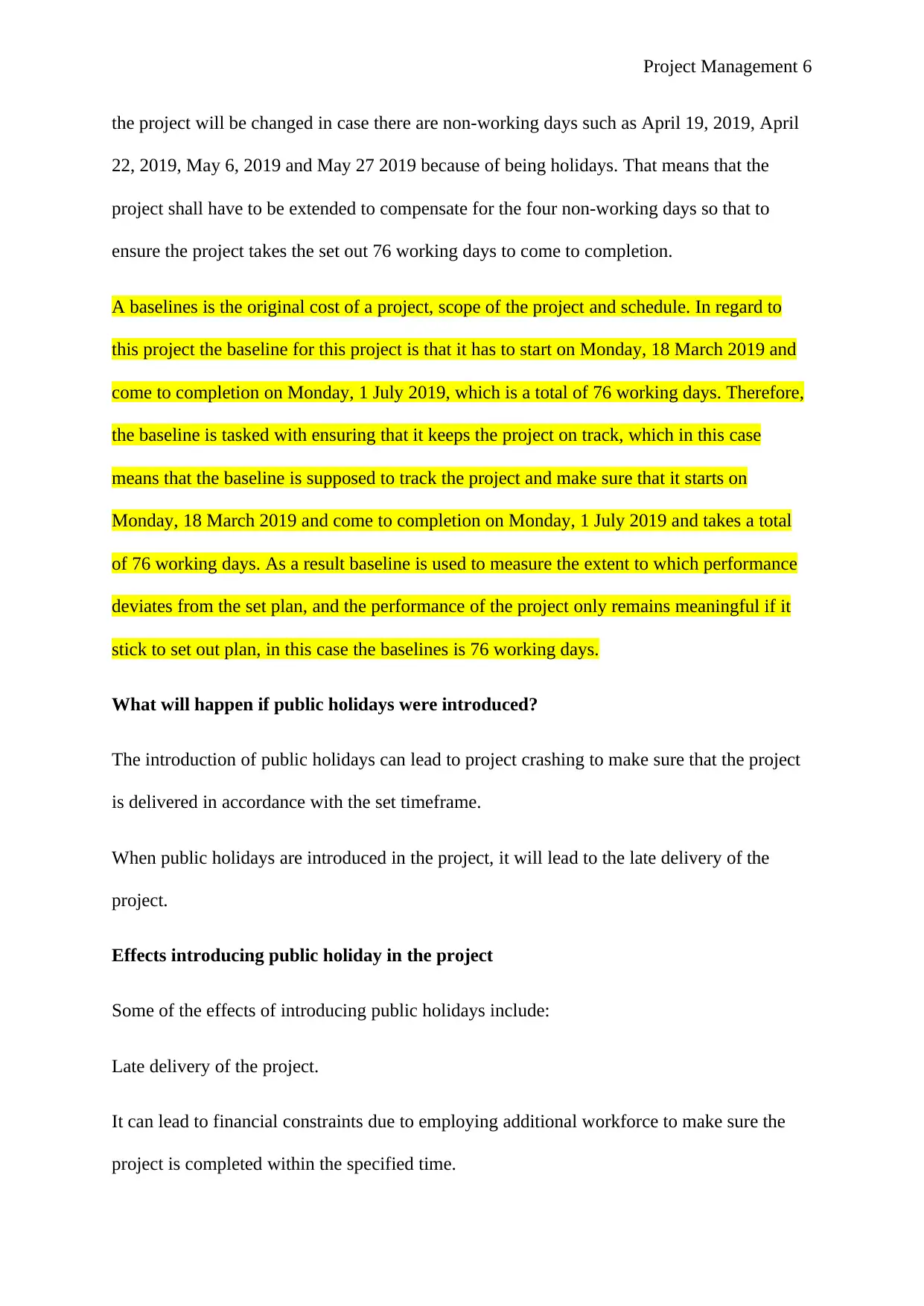
Project Management 6
the project will be changed in case there are non-working days such as April 19, 2019, April
22, 2019, May 6, 2019 and May 27 2019 because of being holidays. That means that the
project shall have to be extended to compensate for the four non-working days so that to
ensure the project takes the set out 76 working days to come to completion.
A baselines is the original cost of a project, scope of the project and schedule. In regard to
this project the baseline for this project is that it has to start on Monday, 18 March 2019 and
come to completion on Monday, 1 July 2019, which is a total of 76 working days. Therefore,
the baseline is tasked with ensuring that it keeps the project on track, which in this case
means that the baseline is supposed to track the project and make sure that it starts on
Monday, 18 March 2019 and come to completion on Monday, 1 July 2019 and takes a total
of 76 working days. As a result baseline is used to measure the extent to which performance
deviates from the set plan, and the performance of the project only remains meaningful if it
stick to set out plan, in this case the baselines is 76 working days.
What will happen if public holidays were introduced?
The introduction of public holidays can lead to project crashing to make sure that the project
is delivered in accordance with the set timeframe.
When public holidays are introduced in the project, it will lead to the late delivery of the
project.
Effects introducing public holiday in the project
Some of the effects of introducing public holidays include:
Late delivery of the project.
It can lead to financial constraints due to employing additional workforce to make sure the
project is completed within the specified time.
the project will be changed in case there are non-working days such as April 19, 2019, April
22, 2019, May 6, 2019 and May 27 2019 because of being holidays. That means that the
project shall have to be extended to compensate for the four non-working days so that to
ensure the project takes the set out 76 working days to come to completion.
A baselines is the original cost of a project, scope of the project and schedule. In regard to
this project the baseline for this project is that it has to start on Monday, 18 March 2019 and
come to completion on Monday, 1 July 2019, which is a total of 76 working days. Therefore,
the baseline is tasked with ensuring that it keeps the project on track, which in this case
means that the baseline is supposed to track the project and make sure that it starts on
Monday, 18 March 2019 and come to completion on Monday, 1 July 2019 and takes a total
of 76 working days. As a result baseline is used to measure the extent to which performance
deviates from the set plan, and the performance of the project only remains meaningful if it
stick to set out plan, in this case the baselines is 76 working days.
What will happen if public holidays were introduced?
The introduction of public holidays can lead to project crashing to make sure that the project
is delivered in accordance with the set timeframe.
When public holidays are introduced in the project, it will lead to the late delivery of the
project.
Effects introducing public holiday in the project
Some of the effects of introducing public holidays include:
Late delivery of the project.
It can lead to financial constraints due to employing additional workforce to make sure the
project is completed within the specified time.
⊘ This is a preview!⊘
Do you want full access?
Subscribe today to unlock all pages.

Trusted by 1+ million students worldwide
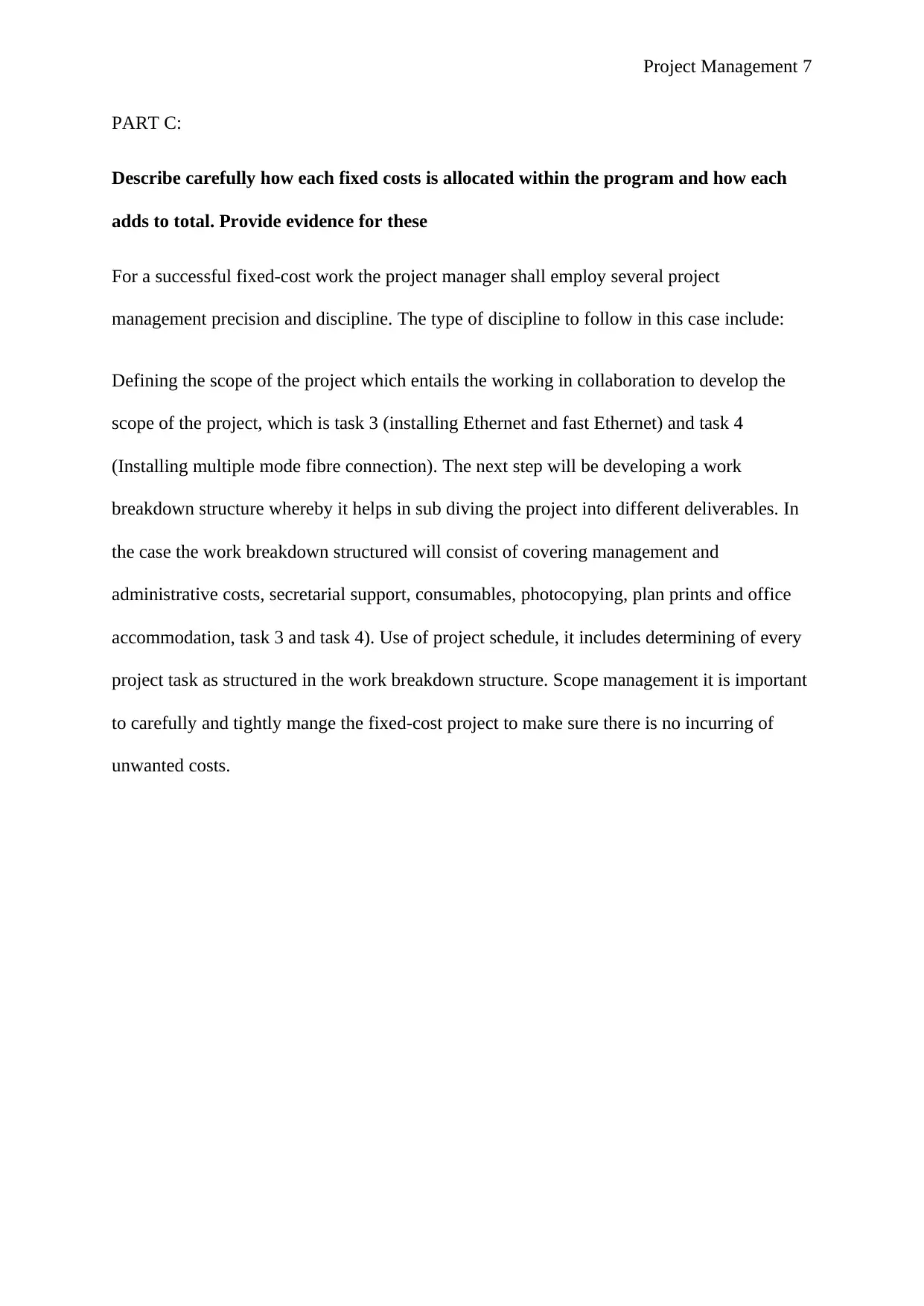
Project Management 7
PART C:
Describe carefully how each fixed costs is allocated within the program and how each
adds to total. Provide evidence for these
For a successful fixed-cost work the project manager shall employ several project
management precision and discipline. The type of discipline to follow in this case include:
Defining the scope of the project which entails the working in collaboration to develop the
scope of the project, which is task 3 (installing Ethernet and fast Ethernet) and task 4
(Installing multiple mode fibre connection). The next step will be developing a work
breakdown structure whereby it helps in sub diving the project into different deliverables. In
the case the work breakdown structured will consist of covering management and
administrative costs, secretarial support, consumables, photocopying, plan prints and office
accommodation, task 3 and task 4). Use of project schedule, it includes determining of every
project task as structured in the work breakdown structure. Scope management it is important
to carefully and tightly mange the fixed-cost project to make sure there is no incurring of
unwanted costs.
PART C:
Describe carefully how each fixed costs is allocated within the program and how each
adds to total. Provide evidence for these
For a successful fixed-cost work the project manager shall employ several project
management precision and discipline. The type of discipline to follow in this case include:
Defining the scope of the project which entails the working in collaboration to develop the
scope of the project, which is task 3 (installing Ethernet and fast Ethernet) and task 4
(Installing multiple mode fibre connection). The next step will be developing a work
breakdown structure whereby it helps in sub diving the project into different deliverables. In
the case the work breakdown structured will consist of covering management and
administrative costs, secretarial support, consumables, photocopying, plan prints and office
accommodation, task 3 and task 4). Use of project schedule, it includes determining of every
project task as structured in the work breakdown structure. Scope management it is important
to carefully and tightly mange the fixed-cost project to make sure there is no incurring of
unwanted costs.
Paraphrase This Document
Need a fresh take? Get an instant paraphrase of this document with our AI Paraphraser
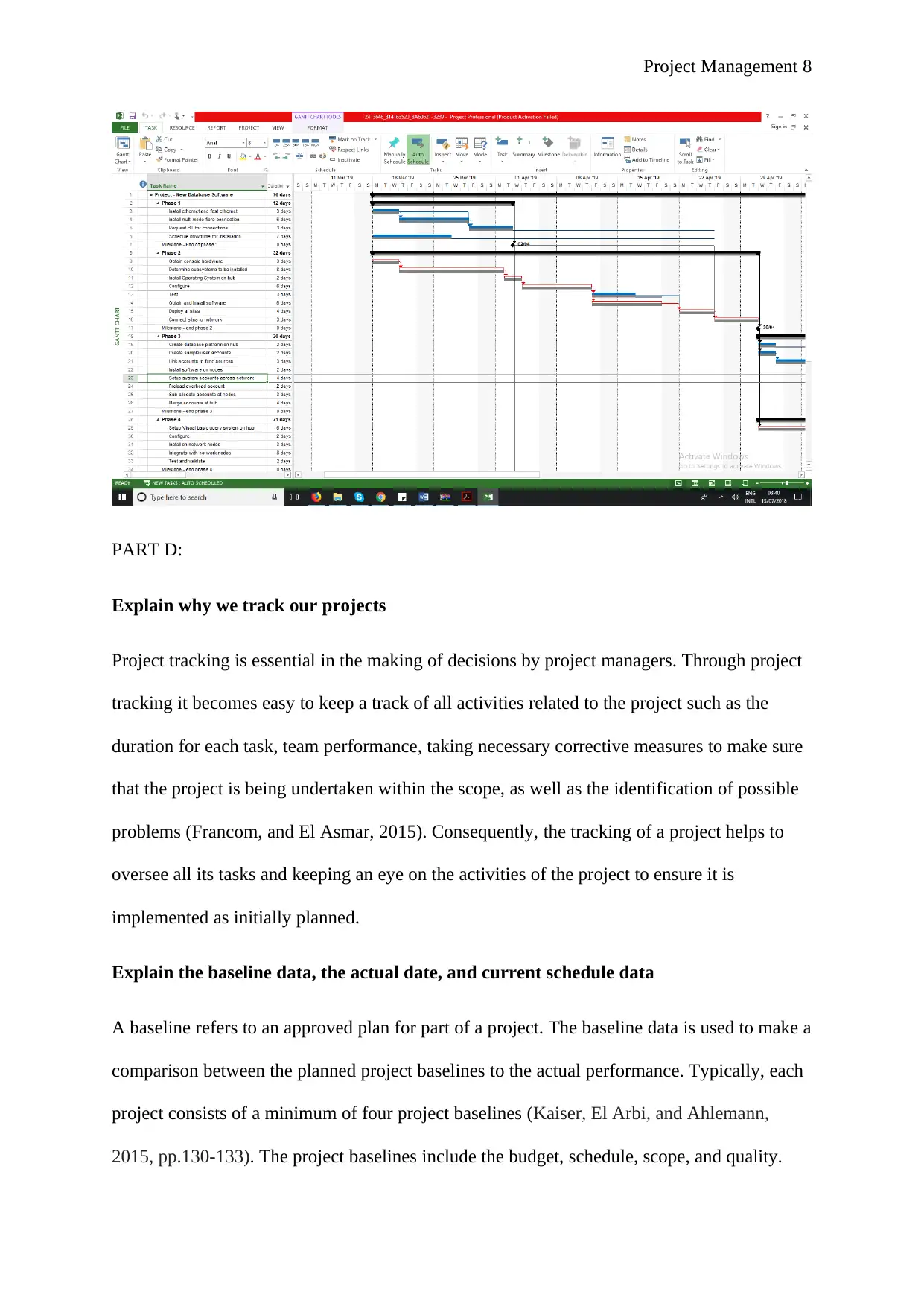
Project Management 8
PART D:
Explain why we track our projects
Project tracking is essential in the making of decisions by project managers. Through project
tracking it becomes easy to keep a track of all activities related to the project such as the
duration for each task, team performance, taking necessary corrective measures to make sure
that the project is being undertaken within the scope, as well as the identification of possible
problems (Francom, and El Asmar, 2015). Consequently, the tracking of a project helps to
oversee all its tasks and keeping an eye on the activities of the project to ensure it is
implemented as initially planned.
Explain the baseline data, the actual date, and current schedule data
A baseline refers to an approved plan for part of a project. The baseline data is used to make a
comparison between the planned project baselines to the actual performance. Typically, each
project consists of a minimum of four project baselines (Kaiser, El Arbi, and Ahlemann,
2015, pp.130-133). The project baselines include the budget, schedule, scope, and quality.
PART D:
Explain why we track our projects
Project tracking is essential in the making of decisions by project managers. Through project
tracking it becomes easy to keep a track of all activities related to the project such as the
duration for each task, team performance, taking necessary corrective measures to make sure
that the project is being undertaken within the scope, as well as the identification of possible
problems (Francom, and El Asmar, 2015). Consequently, the tracking of a project helps to
oversee all its tasks and keeping an eye on the activities of the project to ensure it is
implemented as initially planned.
Explain the baseline data, the actual date, and current schedule data
A baseline refers to an approved plan for part of a project. The baseline data is used to make a
comparison between the planned project baselines to the actual performance. Typically, each
project consists of a minimum of four project baselines (Kaiser, El Arbi, and Ahlemann,
2015, pp.130-133). The project baselines include the budget, schedule, scope, and quality.
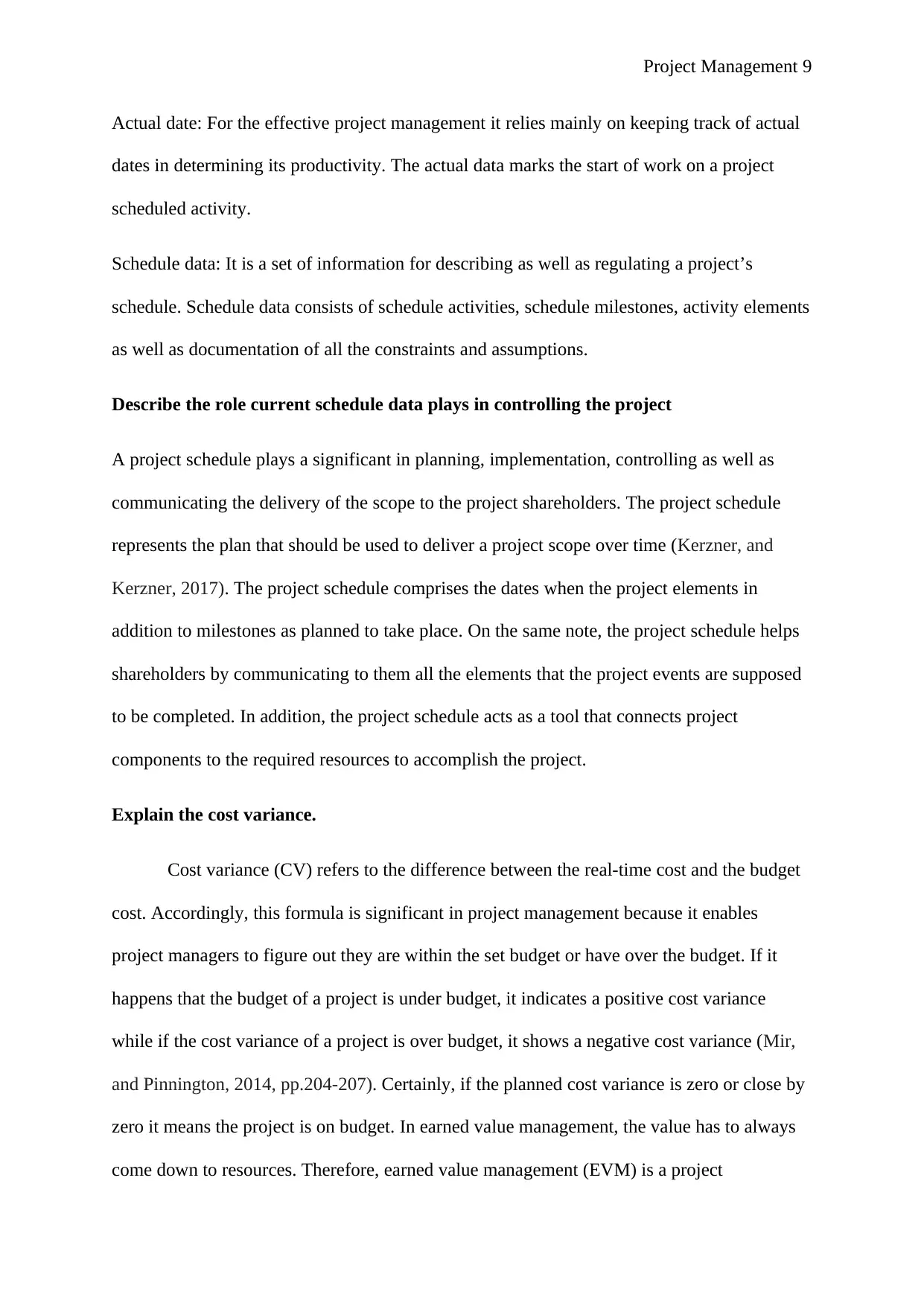
Project Management 9
Actual date: For the effective project management it relies mainly on keeping track of actual
dates in determining its productivity. The actual data marks the start of work on a project
scheduled activity.
Schedule data: It is a set of information for describing as well as regulating a project’s
schedule. Schedule data consists of schedule activities, schedule milestones, activity elements
as well as documentation of all the constraints and assumptions.
Describe the role current schedule data plays in controlling the project
A project schedule plays a significant in planning, implementation, controlling as well as
communicating the delivery of the scope to the project shareholders. The project schedule
represents the plan that should be used to deliver a project scope over time (Kerzner, and
Kerzner, 2017). The project schedule comprises the dates when the project elements in
addition to milestones as planned to take place. On the same note, the project schedule helps
shareholders by communicating to them all the elements that the project events are supposed
to be completed. In addition, the project schedule acts as a tool that connects project
components to the required resources to accomplish the project.
Explain the cost variance.
Cost variance (CV) refers to the difference between the real-time cost and the budget
cost. Accordingly, this formula is significant in project management because it enables
project managers to figure out they are within the set budget or have over the budget. If it
happens that the budget of a project is under budget, it indicates a positive cost variance
while if the cost variance of a project is over budget, it shows a negative cost variance (Mir,
and Pinnington, 2014, pp.204-207). Certainly, if the planned cost variance is zero or close by
zero it means the project is on budget. In earned value management, the value has to always
come down to resources. Therefore, earned value management (EVM) is a project
Actual date: For the effective project management it relies mainly on keeping track of actual
dates in determining its productivity. The actual data marks the start of work on a project
scheduled activity.
Schedule data: It is a set of information for describing as well as regulating a project’s
schedule. Schedule data consists of schedule activities, schedule milestones, activity elements
as well as documentation of all the constraints and assumptions.
Describe the role current schedule data plays in controlling the project
A project schedule plays a significant in planning, implementation, controlling as well as
communicating the delivery of the scope to the project shareholders. The project schedule
represents the plan that should be used to deliver a project scope over time (Kerzner, and
Kerzner, 2017). The project schedule comprises the dates when the project elements in
addition to milestones as planned to take place. On the same note, the project schedule helps
shareholders by communicating to them all the elements that the project events are supposed
to be completed. In addition, the project schedule acts as a tool that connects project
components to the required resources to accomplish the project.
Explain the cost variance.
Cost variance (CV) refers to the difference between the real-time cost and the budget
cost. Accordingly, this formula is significant in project management because it enables
project managers to figure out they are within the set budget or have over the budget. If it
happens that the budget of a project is under budget, it indicates a positive cost variance
while if the cost variance of a project is over budget, it shows a negative cost variance (Mir,
and Pinnington, 2014, pp.204-207). Certainly, if the planned cost variance is zero or close by
zero it means the project is on budget. In earned value management, the value has to always
come down to resources. Therefore, earned value management (EVM) is a project
⊘ This is a preview!⊘
Do you want full access?
Subscribe today to unlock all pages.

Trusted by 1+ million students worldwide
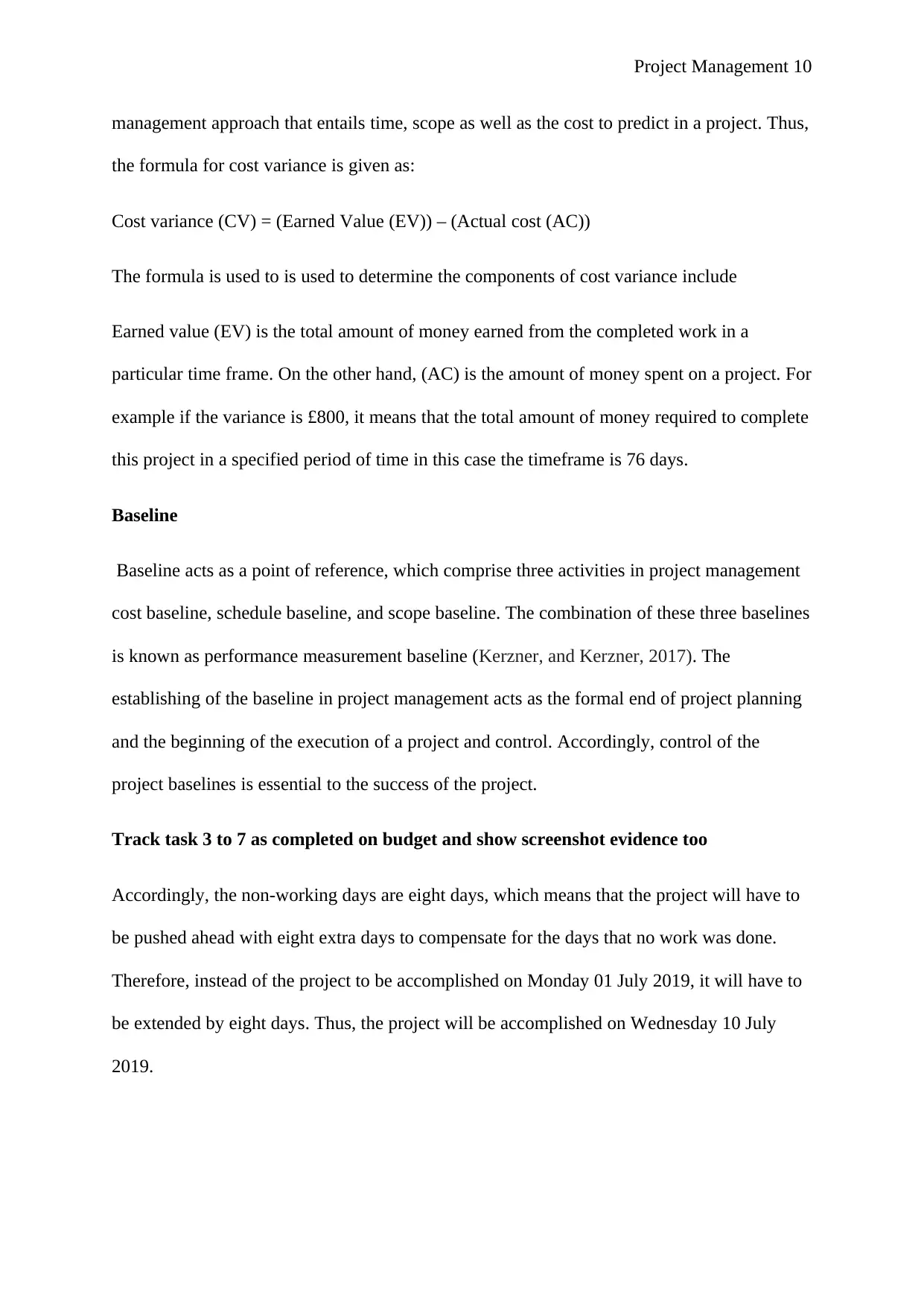
Project Management 10
management approach that entails time, scope as well as the cost to predict in a project. Thus,
the formula for cost variance is given as:
Cost variance (CV) = (Earned Value (EV)) – (Actual cost (AC))
The formula is used to is used to determine the components of cost variance include
Earned value (EV) is the total amount of money earned from the completed work in a
particular time frame. On the other hand, (AC) is the amount of money spent on a project. For
example if the variance is £800, it means that the total amount of money required to complete
this project in a specified period of time in this case the timeframe is 76 days.
Baseline
Baseline acts as a point of reference, which comprise three activities in project management
cost baseline, schedule baseline, and scope baseline. The combination of these three baselines
is known as performance measurement baseline (Kerzner, and Kerzner, 2017). The
establishing of the baseline in project management acts as the formal end of project planning
and the beginning of the execution of a project and control. Accordingly, control of the
project baselines is essential to the success of the project.
Track task 3 to 7 as completed on budget and show screenshot evidence too
Accordingly, the non-working days are eight days, which means that the project will have to
be pushed ahead with eight extra days to compensate for the days that no work was done.
Therefore, instead of the project to be accomplished on Monday 01 July 2019, it will have to
be extended by eight days. Thus, the project will be accomplished on Wednesday 10 July
2019.
management approach that entails time, scope as well as the cost to predict in a project. Thus,
the formula for cost variance is given as:
Cost variance (CV) = (Earned Value (EV)) – (Actual cost (AC))
The formula is used to is used to determine the components of cost variance include
Earned value (EV) is the total amount of money earned from the completed work in a
particular time frame. On the other hand, (AC) is the amount of money spent on a project. For
example if the variance is £800, it means that the total amount of money required to complete
this project in a specified period of time in this case the timeframe is 76 days.
Baseline
Baseline acts as a point of reference, which comprise three activities in project management
cost baseline, schedule baseline, and scope baseline. The combination of these three baselines
is known as performance measurement baseline (Kerzner, and Kerzner, 2017). The
establishing of the baseline in project management acts as the formal end of project planning
and the beginning of the execution of a project and control. Accordingly, control of the
project baselines is essential to the success of the project.
Track task 3 to 7 as completed on budget and show screenshot evidence too
Accordingly, the non-working days are eight days, which means that the project will have to
be pushed ahead with eight extra days to compensate for the days that no work was done.
Therefore, instead of the project to be accomplished on Monday 01 July 2019, it will have to
be extended by eight days. Thus, the project will be accomplished on Wednesday 10 July
2019.
Paraphrase This Document
Need a fresh take? Get an instant paraphrase of this document with our AI Paraphraser
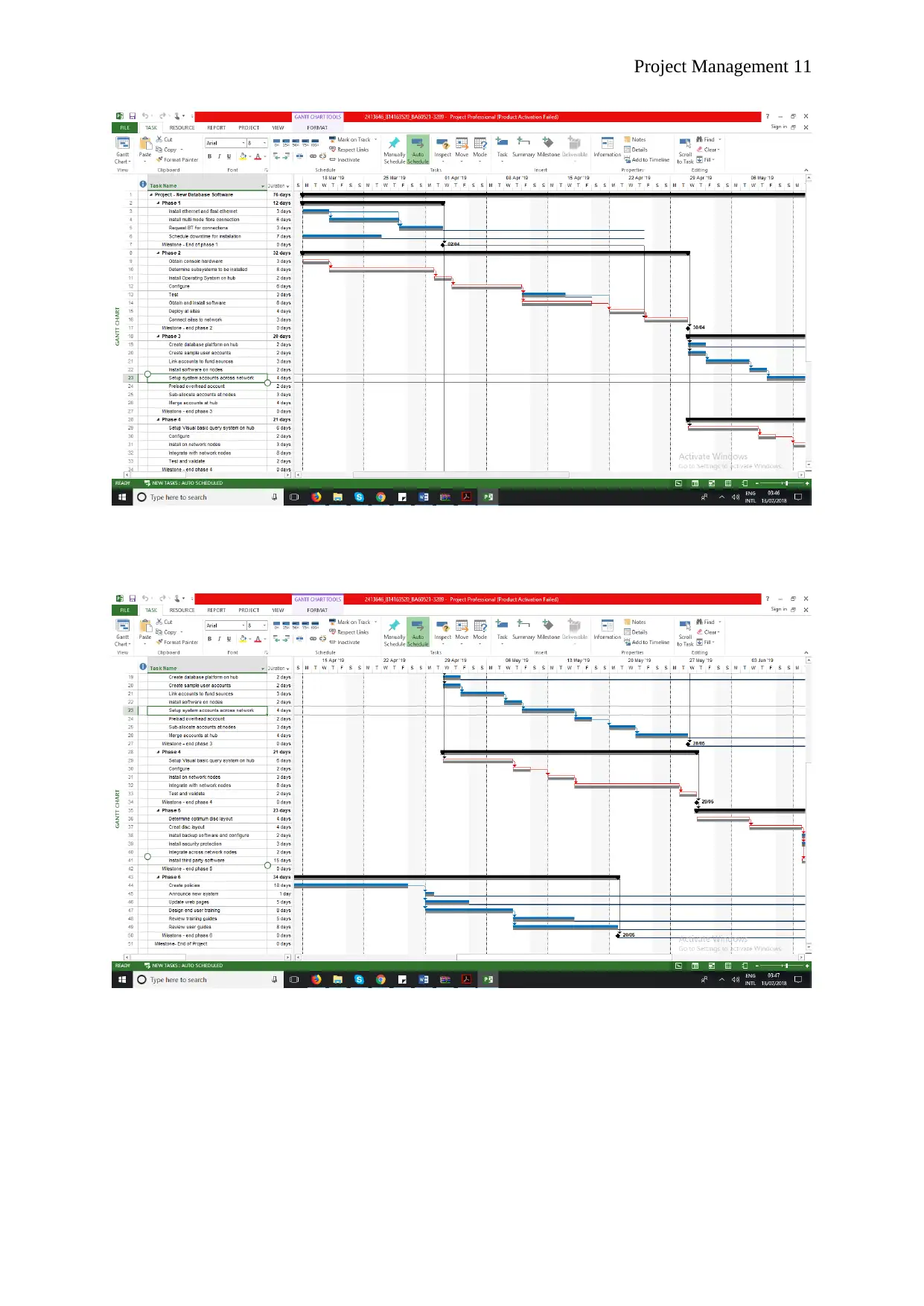
Project Management 11
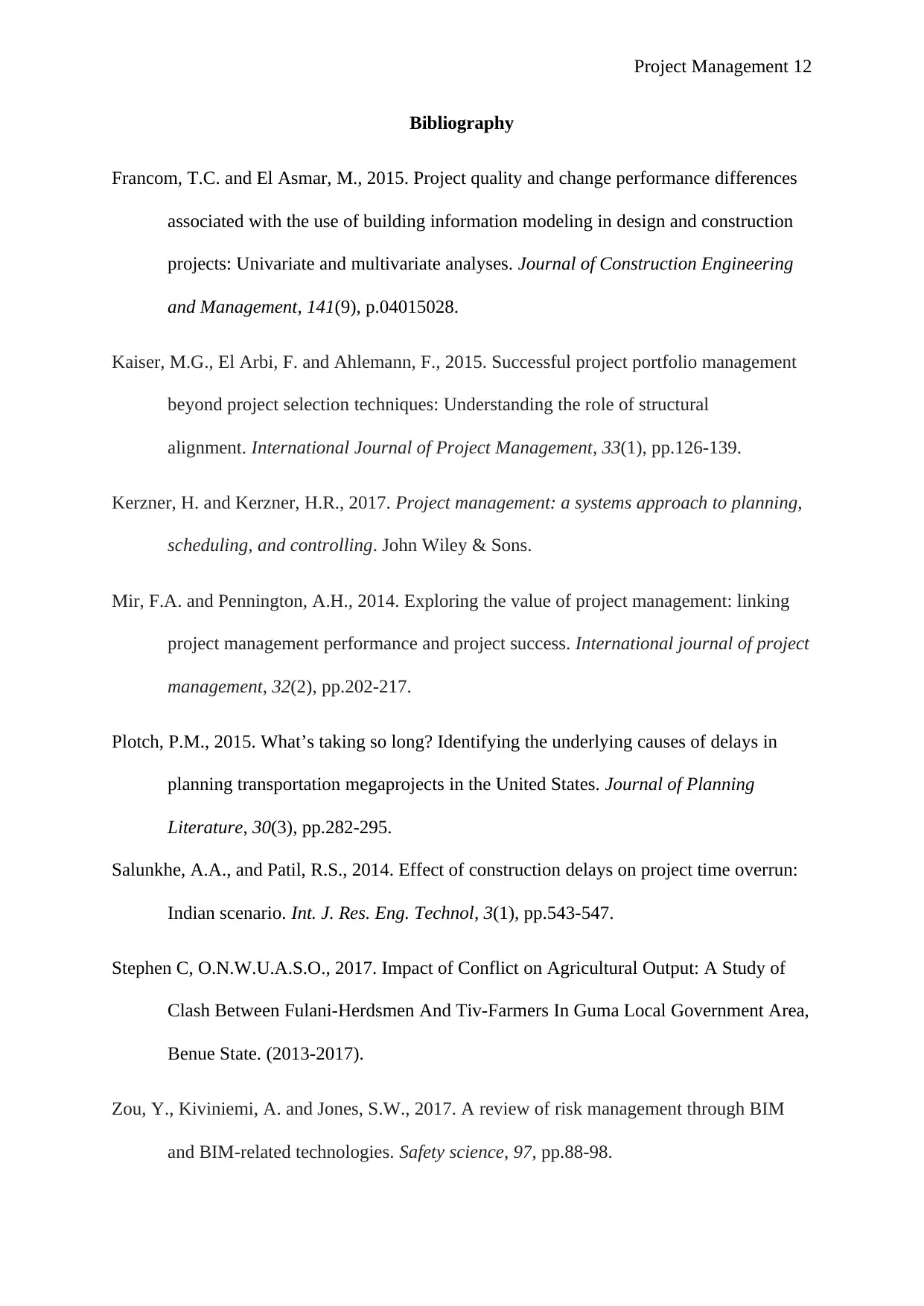
Project Management 12
Bibliography
Francom, T.C. and El Asmar, M., 2015. Project quality and change performance differences
associated with the use of building information modeling in design and construction
projects: Univariate and multivariate analyses. Journal of Construction Engineering
and Management, 141(9), p.04015028.
Kaiser, M.G., El Arbi, F. and Ahlemann, F., 2015. Successful project portfolio management
beyond project selection techniques: Understanding the role of structural
alignment. International Journal of Project Management, 33(1), pp.126-139.
Kerzner, H. and Kerzner, H.R., 2017. Project management: a systems approach to planning,
scheduling, and controlling. John Wiley & Sons.
Mir, F.A. and Pennington, A.H., 2014. Exploring the value of project management: linking
project management performance and project success. International journal of project
management, 32(2), pp.202-217.
Plotch, P.M., 2015. What’s taking so long? Identifying the underlying causes of delays in
planning transportation megaprojects in the United States. Journal of Planning
Literature, 30(3), pp.282-295.
Salunkhe, A.A., and Patil, R.S., 2014. Effect of construction delays on project time overrun:
Indian scenario. Int. J. Res. Eng. Technol, 3(1), pp.543-547.
Stephen C, O.N.W.U.A.S.O., 2017. Impact of Conflict on Agricultural Output: A Study of
Clash Between Fulani-Herdsmen And Tiv-Farmers In Guma Local Government Area,
Benue State. (2013-2017).
Zou, Y., Kiviniemi, A. and Jones, S.W., 2017. A review of risk management through BIM
and BIM-related technologies. Safety science, 97, pp.88-98.
Bibliography
Francom, T.C. and El Asmar, M., 2015. Project quality and change performance differences
associated with the use of building information modeling in design and construction
projects: Univariate and multivariate analyses. Journal of Construction Engineering
and Management, 141(9), p.04015028.
Kaiser, M.G., El Arbi, F. and Ahlemann, F., 2015. Successful project portfolio management
beyond project selection techniques: Understanding the role of structural
alignment. International Journal of Project Management, 33(1), pp.126-139.
Kerzner, H. and Kerzner, H.R., 2017. Project management: a systems approach to planning,
scheduling, and controlling. John Wiley & Sons.
Mir, F.A. and Pennington, A.H., 2014. Exploring the value of project management: linking
project management performance and project success. International journal of project
management, 32(2), pp.202-217.
Plotch, P.M., 2015. What’s taking so long? Identifying the underlying causes of delays in
planning transportation megaprojects in the United States. Journal of Planning
Literature, 30(3), pp.282-295.
Salunkhe, A.A., and Patil, R.S., 2014. Effect of construction delays on project time overrun:
Indian scenario. Int. J. Res. Eng. Technol, 3(1), pp.543-547.
Stephen C, O.N.W.U.A.S.O., 2017. Impact of Conflict on Agricultural Output: A Study of
Clash Between Fulani-Herdsmen And Tiv-Farmers In Guma Local Government Area,
Benue State. (2013-2017).
Zou, Y., Kiviniemi, A. and Jones, S.W., 2017. A review of risk management through BIM
and BIM-related technologies. Safety science, 97, pp.88-98.
⊘ This is a preview!⊘
Do you want full access?
Subscribe today to unlock all pages.

Trusted by 1+ million students worldwide
1 out of 12
Related Documents
Your All-in-One AI-Powered Toolkit for Academic Success.
+13062052269
info@desklib.com
Available 24*7 on WhatsApp / Email
![[object Object]](/_next/static/media/star-bottom.7253800d.svg)
Unlock your academic potential
Copyright © 2020–2025 A2Z Services. All Rights Reserved. Developed and managed by ZUCOL.




